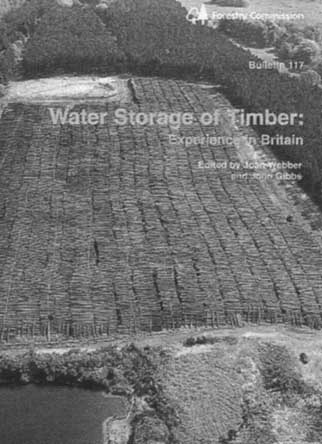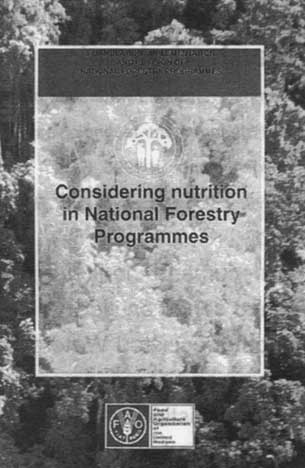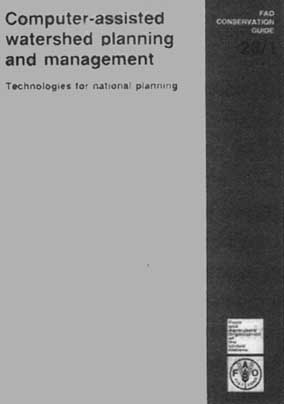Learning from necessity
Water storage of timber: experience in Britain. 1996. J. Webber and J. Gibbs, eds Forestry Commission Bulletin 117 London, HMSO.

From time to time a calamity such as forest fire requires that timber is salvaged quickly. Where such timber is plantation-grown, the investment loss can be catastrophic unless the most valuable timber is saved and then marketed in an orderly way. This publication reports on a successful British experience using water storage. Overhead sprinklers were used to prevent deterioration of high-quality pine logs following the gale of October 1987 when 4 million m3 of timber were blown down in the south of England.
The majority of logs (pine and other softwoods and hardwoods) were stored satisfactorily for up to four years. Throughout this time, detailed investigations monitored water quality, aquatic life, the development of stain and decay and changes in the strength and porosity of the timber. Experience and recommendations for building a wet store and the total costs of the operation are also covered.
The principles outlined should be of interest to many countries, particularly those with significant investments in plantation forestry. Moreover, as detailed in this volume, the effort was a good example of collaboration between forest managers and research scientists to produce a concrete and immediate value for industry.
Improving the aggregate benefit of the forests
Forestry for human development: a global imperative. 1996. H. K. Seip. Oslo, Scandinavian University Press.

This book offers a brief description of the current situation of world forestry and attempts to establish some lines of thinking that might be helpful in the ongoing related discussion.
Chapter 1 takes a look at the factors leading to the current situation and briefly presents a historical background. Chapter 2 gives an overview (similarly brief) of global forest resources. Chapter 3 discusses the variety of important services expected from the forests. Chapter 4 takes up the problem of the degree to which these services can be produced simultaneously. Chapter 5 suggests some possibilities for increasing the compatibility between various services and Chapter 6 tries to point to the path through the thicket of problems at the national level. Throughout, the recognition of international responsibility is emphasized as a prerequisite for finding solutions near the optimal aggregate benefit of forests.
This volume will be of interest to organizations dealing with development assistance as well as professionals and others interested in forestry, geography and social economics, including politicians, researchers and students.
The author was Norway's Director-General of Forestry from 1967 to 1933 and has subsequently served as a forestry consultant in various parts of the tropical world.
Nutrition and national forestry programmes
Considering nutrition in national forestry programmes. 1996. By C. L. Ogden. Rome, FAO

Household food security, or the lack of it, and malnutrition are closely linked to deforestation. On the one hand, the decrease and degradation of existing natural resources owing to unsustainable practices affect the way in which local people obtain and prepare their food and lead to unhealthy environments. On the other hand (and of more concern to foresters and environmentalists), the unsustainable exploitation of natural resources is often the only approach available to poor households that need to increase food production and generate income to feed their families.
Furthermore, forestry activities often affect access to land and forest products. Therefore, it is essential to consider these impacts to ensure that forestry activities do not further disadvantage the poor but rather improve their overall well-being.
This brief publication focuses on the relationship between forestry and nutrition. It provides specific information about how national forestry programmes can incorporate considerations on nutrition and food security.
The publication is a practical guide for national forestry programme coordinators, their teams and all interested individuals, it is divided into four sections: a general introduction; a section on the importance of nutrition and household food security in national forestry programmes; a section on how to incorporate considerations on nutrition and household food security in such programmes; and a final section providing sources of further information.
As such, this publication is of potential value during strategic planning, during the preparation of specific studies to analyse forestry and forest-related sectors and in processes of policy-making and planning. It also provides a means to link national forestry programmes with efforts associated with follow-up to the 1992 International Conference on Nutrition and to the 1996 World Food Summit.
Using computers in watershed planning
Computer-assisted watershed planning and management: technologies for national planning. 1996. FAO Conservation Guide No. 28/1. Rome, FAO.

This document, the first in a planned series entitled Computer-assisted Watershed Planning and Management, aims at assisting watershed managers and planners to apply modern computer technologies to national level watershed management planning.
Since the late 1980s, computer hardware and software that can be used to assist watershed planning and management has become more available, more powerful, less expensive and easier to use. Interest is growing in the use of these technologies in developing countries. This series of manuals Is planned as a response to this increased interest and availability of computer technologies and is intended as a practical guide for the use of computers in watershed planning and management. The manuals do not provide detailed instructions for the use of specific computer systems. Rather, they attempt to provide an overview of the technologies available and a set of general processes that can be implemented regardless of the computer systems used.
This particular manual concentrates on national watershed survey and priority rating. In the first part of the manual, fundamental concepts and techniques are set out to provide a basic understanding of the processes involved. The second part of the manual provides an overview of computer hardware and software as well as associated technologies. In addition, the second part provides a brief example of how these technologies can be used in an integrated manner to accomplish many of the tasks involved in national watershed survey and planning. The third part of the manual summarizes a set of case-studies to provide insight into how groups around the world have approached various parts of national watershed surveys and rating and, in some cases, how computer technology was used.
The use of computer hardware and software for watershed planning and management can be a two-edged sword. On the one hand, use of these technologies can be expensive and time-consuming and can draw important resources away from other aspects of watershed conservation efforts. On the other hand, proper implementation can save time, money and other resources while enhancing all levels of watershed management and planning. Before implementing computer technologies, there must be a good understanding of them as well as their costs and potential. This manual provides a first step in the right direction. Its target audience includes watershed managers, planners and field project officers working in developing countries.
Future manuals in the series will focus on master planning for priority watersheds, participatory planning at local, subwatershed levels and hydrological modelling.